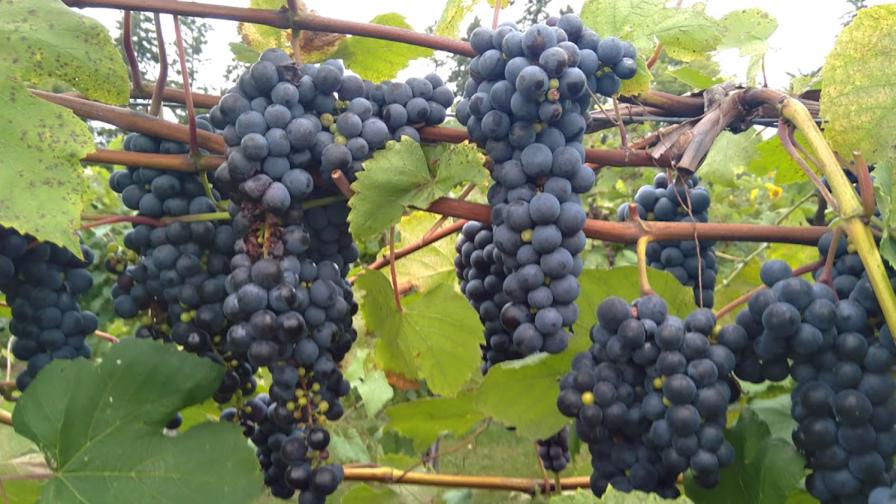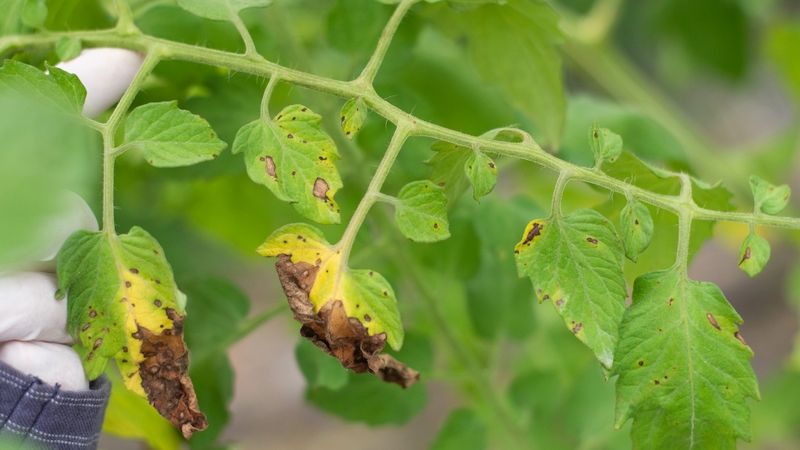How To Make Potassium Content Count When Growing Grapes

Leaf removal exposes grape clusters to sunlight, leading to faster ripening and more balanced acidity.
Photo by Annie Klodd
As grapes move past veraison and toward ripening, they accumulate sugars and anthocyanins and undergo changes in nutrient content and berry structure.
In turn, the berries become less acidic and sweeter; their pH increases by roughly one whole unit. Titratable acidity decreases significantly, while Brix increases significantly.
“Generally speaking, berries with lower titratable acidity and higher pH will make lower-acid wines,” says Annie Klodd, Extension Educator, Fruit Production, University of Minnesota.
A perhaps less-obvious predictor of wine acidity, Klodd says, is the potassium content of the berry. And while it is well studied in research, many grape growers and wine makers, she adds, may not be fully aware that the amount of potassium in the berry can also determine the acidity of the wine.
TOO MUCH POTASSIUM
Grape skins are “sinks” for potassium, Klodd says. As the berries ripen, their skins accumulate a lot of potassium, which helps enable shoot and fruit growth in grapevines throughout the season. The nutrient also enables proper fruit ripening in the latter part of the season.
“However, there can be too much of a good thing,” Klodd says.
Under certain circumstances, the berry skins can accumulate too much potassium. This excess potassium can cause free acids, like tartaric acid, to precipitate out during the first few days of fermentation. The result is a must and a wine with a high pH.
Researchers have found that, even if grapes are harvested at the correct pH range, excessive potassium can still raise the wine pH to unacceptable levels during fermentation.
“The concentration of potassium in the skin is much higher than in the pulp or the seeds,” Klodd says. “Therefore, excessive potassium is a more significant problem for red wines that are fermented with the skins. This is less of a concern for white wines.”
The problem is common, according to Extension specialists with Penn State University. They have noted more calls received from growers about excessive potassium than deficient potassium.
How much is too much? In general, Klodd says, a concentration of 50 millimoles per liter is considered excessive. Few growers have their potassium content measured, but there is a lab test available for growers who want to measure this.
HOW TO MANAGE
Several different vineyard management practices can be tweaked or adjusted to make small changes in wine acidity, Klodd says.
“The good news,” she adds, “is that you may be already doing most of these things, as they are widely recommended for maintaining overall vine health anyway.”
Factors impacting acidity include sun exposure to the clusters, fruit load, fertilizer inputs or soil nutrient availability, harvest timing, and variety selection.
Researchers have found that more shaded clusters tend to be more acidic. They ripen more slowly, and therefore pH increases more slowly than on clusters exposed to more sunlight. Likewise, potassium is generally higher in more shaded clusters, sometimes to excessive levels.
“However, the mechanism behind that is not well understood,” Klodd says. “While it is healthy for clusters to have some level of shade, aim for a balance, so they can ripen properly.”
Managing the amount of shading on clusters can be done through proper canopy management, including dormant pruning, shoot thinning, and mid-season leaf removal. Additionally, nitrogen fertilization should be avoided unless a deficiency is present, since nitrogen promotes vegetative growth and can lead to an overly large canopy.
“For growers who wish to be even more precise with their canopy management, they could even leave more canopy on the south and west sides of the rows, where the vines get hit by direct sunlight in the afternoon, and leave fewer leaves on the north and east sides,” Klodd says.
May is the time of the season to shoot thin while the shoots are tender enough to remove by hand, Klodd says. A general guideline for shoot thinning is to thin down to two shoots per spur or six or seven shoots per linear foot. Remove any extras, selecting shoots for removal that are less fruitful or weaker. If possible, keep shoots that are closer to the base of the spur to manage spur creep over time. Thin when shoots are between 4 to 11 inches long.
Leaf removal is a common practice in most wine-growing regions, but many Midwest vineyards still do not practice consistent leaf removal from year to year, according to Klodd.
“It is time consuming but helps greatly to improve air flow and sun exposure,” she says. “The best time to do leaf removal is when the berries are between bloom and pea sized. Waiting too long to remove leaves can shock the berries and cause them to be sunburned.”
NUTRIENT TESTING
Another way to manage acidity is to make fertilizer decisions based on soil and foliar nutrient tests. Since nutrient dynamics can impact pH, especially potassium, growers should aim for sufficient nutrition to meet the vine’s needs without adding excess.
Soil specialists generally recommend doing a routine soil test every three to
five years in either the spring or fall. Growers who suspect a nutrient deficiency based on leaf symptoms or lack of vine vigor can take a soil test whenever they suspect a problem.
Foliar or leaf tissue tests should be taken every year, either at bloom or veraison. If growers are diagnosing problems like leaf discoloration, they can take foliar tests at any time, but these tests must include at least two samples: one for the problem leaves, and one for the healthy leaves for comparison.
“If your test reports state that nutrient levels are high, do not add foliar or soil amendments,” Klodd says. “Only add amendments for the nutrients that
are deficient.”
Finally, growers should harvest their grapes at the recommended ranges for pH and titratable acidity. University of Minnesota varieties include ‘Frontenac’ (3.0-3.3 pH; 10-15 g/L), ‘Frontenac Blanc’ (2.9-3.2; 10-15), ‘Frontenac Gris’ (~3.0; ~14) , ‘Itasca’ (3.04-3.31; 8-11), ‘La Crescent’ (2.9-3.2; 11-15), and ‘Marquette’ (2.9-3.3; 11-12).










